Warcraft Retrospective 4: Warcraft 1, the Human Campaign and Closing Thoughts
Now that we’re done with the Warcraft 1 orc campaign, let’s look at the other side of the conflict.
Like I said last time, the two campaigns have directly contradictory plots. They’re alternate histories, not parts of a single large narrative. I’ve also noted that despite the storylines of both campaigns being really basic, the human campaign has more awkward writing than the orc one. I’m not sure if it’s a result of having different writers or a single writer who paid less attention to these particular missions.
The Gameplay
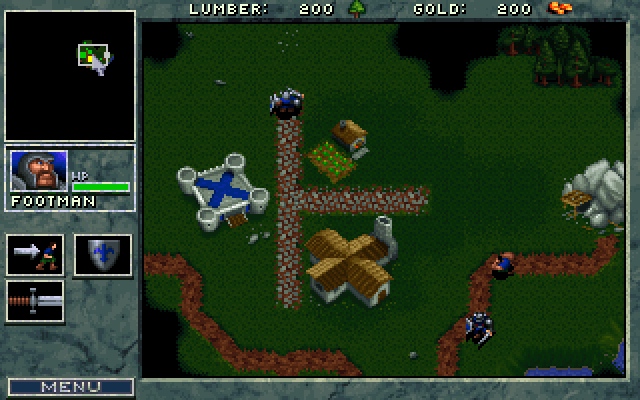
Like I noted, all non-caster units in this game have identical stats to their enemy counterparts, so the core mechanics involving base building, workers, and martial units are exactly the same. Unfortunately, this makes playing one campaign after the other feel like even more of a chore.
All the gameplay jank is still there. Just like orc units used the same voice lines consisting of growls and untranslated words in Orcish, here, all human units share the same voice set. There are exactly two voice lines acknowledging your orders, which are “yes” and “yes, my lord”. Prepare to hear them over and over again, from mission to mission, as you micromanage your units.
The game engine can only handle two opposing sides, one of which is colored red and the other blue; it’s reflected on buildings and on unit livery. In the orc campaign, your side is red, and in the human campaign, your side is blue. Each campaign also has a mission where you fight your own faction, and the enemy uses the other color. So in the human mission dealing with renegade humans, the enemy is red, and in the orc mission where you betray Blackhand, his units are inexplicably blue.
The pathfinding in this game is atrocious. Dungeon crawling missions are designed as space-filling paths, but the unit AI doesn’t know how to navigate them. If you reach the end of the dungeon and then command a unit to come back to the entrance, it won’t go through the winding path you’ve already explored and cleared. It will reach the wall that blocks a straight-line route and just stand there. You have to guide it all the way back, manually.
None of this is particularly bothersome on is own, especially considering how old this game is, but Warcraft 1 really hasn’t aged well.
The Story
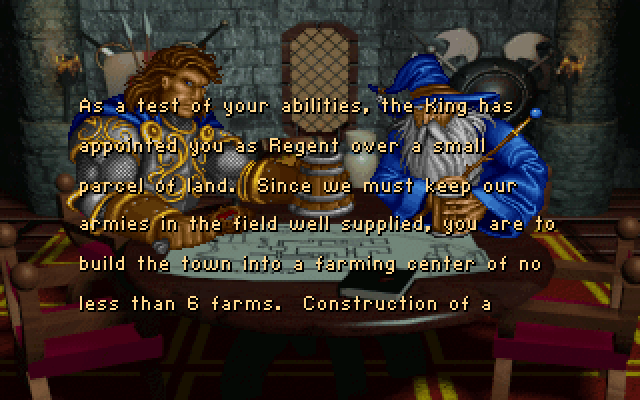
Like in the orc campaign, all storytelling is done through the mission briefings, with scrolling text and voice-over narration. Instead of two cartoony orcs in Lost Vikings-inspired armor, here we have a ripped warrior and a blue Gandalf knockoff1 sitting at a war table. Neither of them is named, and neither of them is supposed to be you, since the human campaign shows your character in the ending cutscene2, and he looks different.
The human campaign is almost a mirror image of the orc one. To wit:
- The King appoints you as Regent over a small parcel of land, and tells you to build a barracks and six farms. This is the first of the weird word choices in this story. A regent is a temporary ruler of a monarchy appointed when the monarch is underage or is otherwise unfit to govern. Since the order comes from the King, he is clearly in charge, and by the story logic, you are more of a regional governor, or perhaps a feudal lord granted a fiefdom.3
- You are tasked with defending the town of Grand Hamlet4 from invading orcs.
- You destroy the orcish outpost of Kyross that the narration says lies deep within the Swamps of Sorrow, but the 3D map actually shows it to be right next to Stormwind.
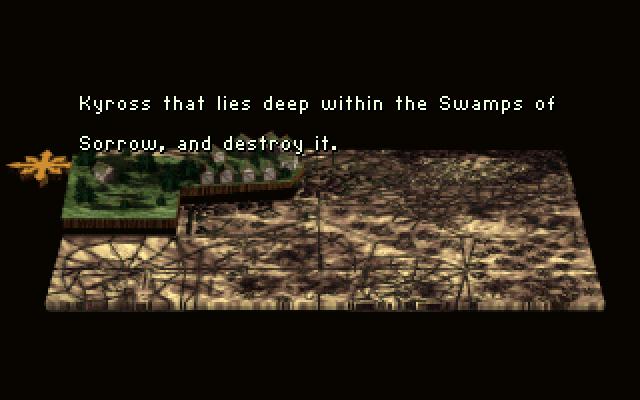
-
You are sent to find Sir Lothar, who went into the Dead Mines twenty months ago to search for the lost Tome of Divinity and never returned. Recently, he appeared in a vision to the Abbot of Northshire, “battered and pleading for assistance”, and so you’ve been given warriors and healers to rescue him.
This setup is bizarre. They waited twenty months before mounting a rescue expedition? The plot of a typical WoW expansion takes place in less time than this. Weren’t they curious what the kingdom’s exemplar knight was doing in a mine all this time, without supplies and without reporting back to the kingdom about his progress in his search? Why is the Tome of Divinity so important, anyway? And what is it doing in a mine?
Whatever. This is a dungeon crawling mission where you command a limited number of troops. You discover that the Dead Mines have been overrun by ogres, find Lothar and his troops in a room at the end as special “wounded” units, and when you move your soldiers near them, they turn into a unique Lothar unit and some archers. You escort them back to the Hostage Rescue Zone, and the whole ogre situation and the Tome of Divinity are not brought up again.
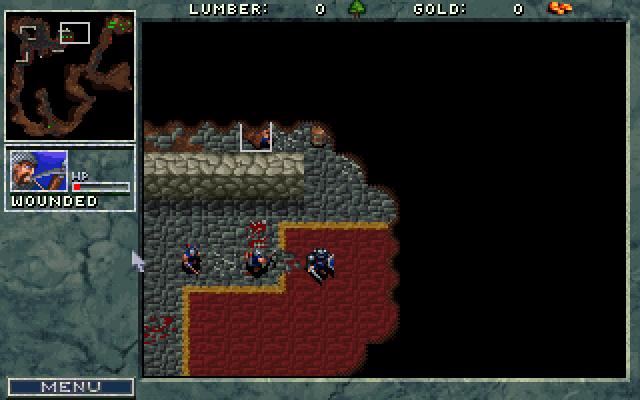
-
You destroy an orc base in the Forest of Elwynn, which is the key to securing the Borderlands.
As an aside, I never understood why the forest was named “Elwynn”. It sounds like “elven”, which might imply that the local humans had some kind of myth that the forest was once inhabited by elves or something. But then in the next game, we discover that elves really exist in this world, but no subsequent lore mentions any kind of elves ever living anywhere near Elwynn Forest. It’s actually fortunate that they never established the origin of the name and thus didn’t have to retcon it.5
-
Northshire Abbey is overrun by “a band of warriors that have been convinced by enemy agents to fight against the crown”. This is this campaign’s obligatory mission where you fight your own faction; the enemy here is a faction of renegade humans that uses the same tech tree as you.
This is another really strange setup. Unlike the orc campaign, where the Civil Warcraft mission has you betraying Blackhand, here you’re fighting some unnamed human faction that’s said to be in league with some unnamed enemy agents. What enemy agents? Orcs? It’s frustratingly vague and is, once again, never brought up again. A missed worldbuilding opportunity.
This mission also shows the limitations of the RTS format. Like in most other missions, the objective is to destroy all enemy units and buildings. But since these are human buildings, it feels like you’re ruining perfectly good infrastructure just to spite the renegades.
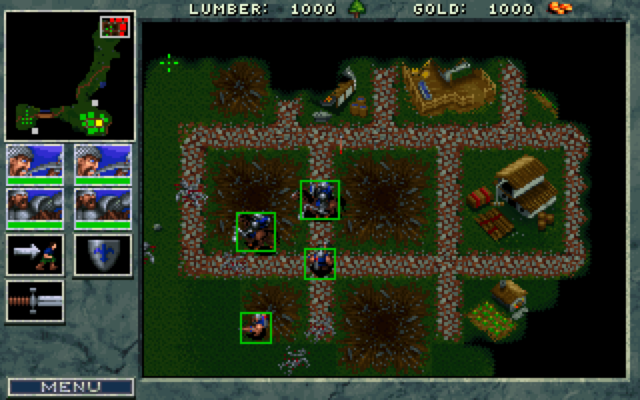
-
You liberate the village of Sunnyglade6 that has been taken over by orcish slavers, who keep the captured villagers as slaves.
Here is another awkward wording choice. Slavery implies forced labor, but the captured villagers here aren’t put to any kind of work. They are just rounded together behind an enclosure, watched over by orc guards. They’re not slaves, they’re prisoners. I understand that the engine doesn’t allow showing the human peasants engaged in forced labor, but the answer is not to write a story that isn’t supported by the gameplay.
It also conflicts the manual, which shows that orcs don’t take slaves or prisoners when raiding human villages. They simply kill everyone, men, women and children, and then eat their livestock. This is consistent with their “swarm of demonic locusts” characterization from the manual. It’s not explained why the orcs in this mission act differently.
To add insult to injury, despite what the mission objective claims, rescuing the prisoners doesn’t even seem to be necessary. The slaves, or prisoners, whatever, are tucked into the edge of the map. In my playthrough, I didn’t even discover them; I just destroyed the orc base, and the game recognized that as a victory condition. I’m not sure if it was a bug or intended behavior, but it’s possible to finish this mission without ever seeing the people you’re supposed to save.
-
As an intermission from fighting orcs, you have another dungeon crawling mission with a limited army. You are called to put an end to the evil warlock Medivh, who has been draining the soul of the land itself from his tower. Weirdly, the mission briefing claims that “legend speaks of his ability to command daemons of Hell”, implying he’s been around long enough for legends to form around him — another inconsistency with the manual.
The “tower” is, of course, presented as another underground dungeon in-game, because the engine doesn’t support anything else. It’s a winding, space-filling path where you fight elementals, spiders, oozes and skeletons, ending with Medivh himself and two daemons (one already present on the map and one summoned by Medivh as you approach him). It’s not much, but it’s a break from the tedium.
Incidentally, when talking about the manual, there was one detail I missed. Through the words of Medivh’s yet-unnamed mother, it states in no uncertain terms that it was he who brought the orcs to Azeroth — inadvertently, during a duel with his father — and they were too chaotic for him to control. Yet here, in-game, Medivh is somehow evil and attacking fellow humans without provocation, and it’s never explained why.
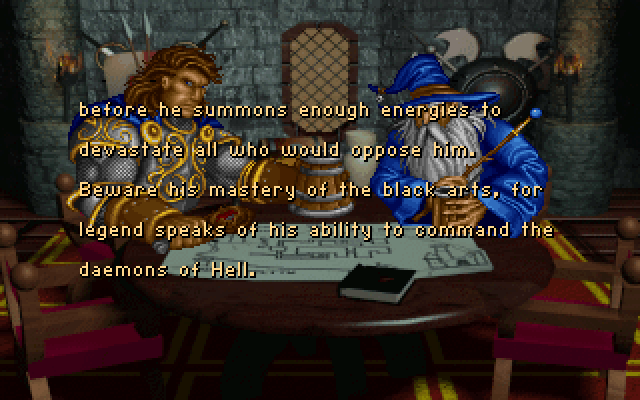
-
From here on, in a mirror of the orc campaign, it’s just fighting orc bases in the east. First you fight two unnamed bases. Then you assault the Temple of the Damned, which is a temple-shaped orc base with an unusually high population of warlocks and necrolytes. Then you raze the orc towns of Rockard and Stonard.7 Finally, you fight three large orc bases with Black Rock Spire as a unique building in the center, similar to Stormwind Keep, its counterpart in the orc campaign. (Black Rock Spire indeed looks like a rock. I have this mental image of footmen leveling a rock by hitting it very hard with their swords.)
This is pretty bog standard, except for one weird tangent: in the briefing for the Temple of the Damned mission, you are offhandedly told that King Llane was “assassinated by the treacherous Garona, at Stormwind Keep”, and declared you War Leader with his dying breath. I understand that production values didn’t allow them to actually show a cutscene for this pretty drastic plot development, so we’re only told about it in narration. I’m willing to let things like this slide and give developers leeway when they make concessions for pragmatic reasons, so I’m not going to dwell on this any more– RENEGADE INTERRUPT!
This is the third time by now that we see the campaign writer pick a word inappropriate for the situation. Treacherous Garona? Treachery implies being stabbed in the back by a party you worked together with and trusted, but nowhere in the entire game, including its manual, is there any indication of Garona ever working together with the humans.8 She’s the in-universe writer of the orc manual, she apparently spent all her life on the orc homeworld, and she’s captured by humans at Northshire Abbey in the orc campaign. That orc mission says she “has valuable information”, implying she’s a scout or spy or something along that vein, but there’s no indication of her infiltrating human society, let alone King Llane trusting her enough for his assassination to be considered treachery. We also don’t learn how she got into Stormwind Keep, nor what happened to her after.
The writer drops this bomb about Llane’s assassination at the beginning of a mission completely unrelated to happenings in Stormwind, paints a confusing and vague picture because of the strange wording, and refuses to elaborate further.
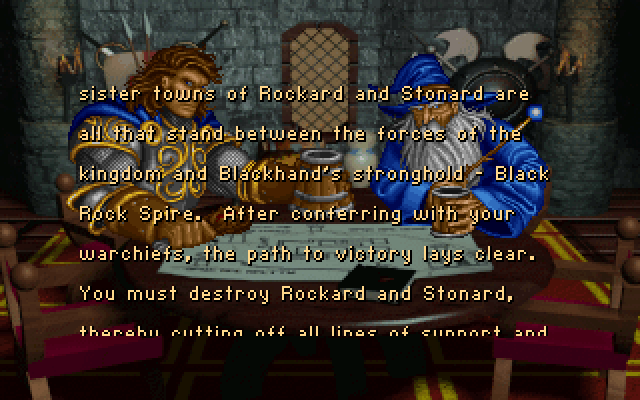
But whatever. Black Rock Spire is destroyed, and we transition into…
The Finale

The fall of Black Rock Spire spelled final victory for the forces of Azeroth. With Blackhand slain and their stronghold destroyed, the few scattered Orcs that remained were quick to bow before your might. A celebration ensued that lasted for many days and many nights, with music and joyous festivities resounding throughout the land. The people of the kingdom have come from miles around to gather at Stormwind Keep, and are delighted by a display of mystic sights and sounds provided by the court conjurers while being treated to a feast of unequaled splendor. Amidst the celebration, your ascension to the throne is acknowledged by your new subjects, and you are given the honorarium Defender of the Crown. As the evening’s celebration continues into the early hours of the morning, you retire to the sanctity of your throne room…
The duty of ruling Azeroth is an awesome responsibility, and should prove to be your greatest challenge yet. Learning the intricacies of court politics alone will be like sailing in uncharted waters. King Llane was renowned for ruling with a fair and just hand, and you resolve to be as proficient as he was. There is also the matter of discovering the exact location of where the Orcish hordes entered into this world, and divining a way to end the threat of another invasion forever - but that is a story for another time…
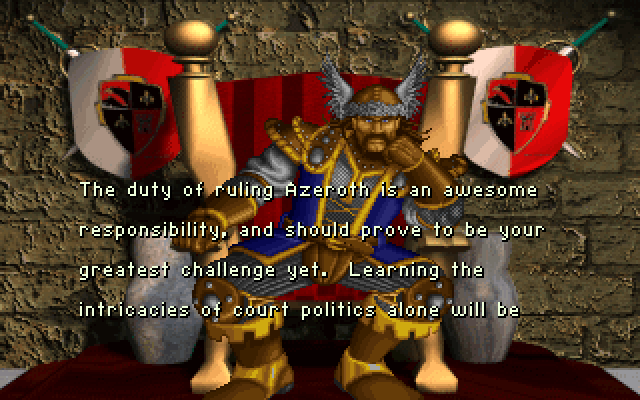
The king is dead, long live the king — your character in this campaign, Guy McBeardson. Unlike the nameless commander you play in the orc campaign, who later got a name and a role in the events of Warcraft 2, this guy isn’t mentioned in any future lore, and we don’t learn his name. He’s not Lothar, because Lothar is present in the campaign as a separate character whom you rescue. Under the weight of retcons upon retcons, it seems he has simply been written out of continuity.
I’ve been more nitpicky about the human campaign than the orc one, and that’s because it feels to me like it hasn’t been proofread to the same extent. Like someone approved the first draft of the mission briefings without thinking much. The reason I’ve done this is that, since the narration is so condensed and is our main source about the story that unfolds in the game itself, we have to extrapolate a lot from the information given, which is hard when the narrator seems confused.
Sure, it might sound like pointless hair-splitting to argue about the meanings of the words “regent”, “slave”, and “treacherous”, or to complain that the king waits for Lothar for twenty months before sending a rescue expedition. But constraints are supposed to breed creativity, and there wasn’t much text for the writer to write; they could at least give us the courtesy of making the intent clear. It might not seem like a big deal. This didn’t bother me. This can be handwaved away. This is explained in later lore. But we wouldn’t have to smooth the story with headcanon if the writer was more diligent, and the existence of sequels (which wasn’t at all guaranteed when Warcraft 1 was being made) doesn’t excuse sloppiness here and now.
All the problems with the mission briefings could have been fixed with just slight rewording, if anyone cared to do so. This is all the more baffling considering the manual is pretty well-written in comparison. Sadly, this will be a recurring pattern with Warcraft game writing going forward.
Final Thoughts on Warcraft 1
Warcraft 1 is, by modern standards, not a fun game to play.
The gameplay is slow and clunky, lacking many later developments in RTS game design, the missions are repetitive slogs, and the campaign stories are basic. Even if you’re a retro gaming fan, there is no real reason to play this particular game when Warcraft 2 is a more extensive, polished, varied, and fun iteration on the same basic design.
Finally, it seems like the manual writer and the game artists weren’t on the same page. The manual presents a gritty Diablo-esque world where the orcs are basically hellspawn locusts defiling the very land they walk on. The game’s graphics are more cartoony – they had to be because of the graphical limitations of that time, forcing the use of a limited palette of bright colors and distinct, recognizable shapes. I mean, look at these guys!
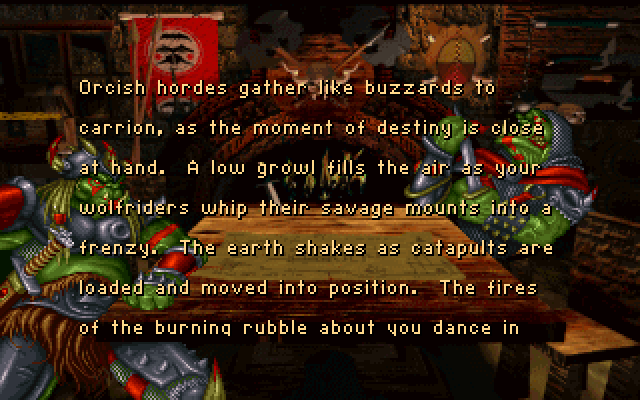
These orcs don’t look like vicious warriors and masters of all things dark and evil. They look like affably evil minions from a Saturday morning cartoon who are going to bungle the big bad’s plan of the week, prompting the big bad to rant how he’s surrounded by incompetent oafs. And mind you, it’s an interesting art direction compared to Tolkienesque deformed monsters who inspire more pity than fear, and no amusement whatsoever. But there’s still a tonal dissonance. The story also takes itself completely seriously despite the narration being read in a rather bombastic, and somewhat amusing, tone.
I think Warcraft 1 is best thought of as a pioneer, stumbling around in uncharted territory, throwing gameplay and aesthetic ideas at the wall and seeing what sticks. Its influence on the franchise as a whole is undeniable — besides laying down the basic RTS mechanics, it gave us the idea of the orc-human conflict, them being from different worlds, and introduced characters and background lore that remain relevant even today — but it’s barely recognizable as being part of the Warcraft universe as it exists now, twenty-nine years later.
What’s next?
Despite complaints about some game mechanics, Warcraft 1 was a critical and commercial success and secured Blizzard financially. It’s important to realize that we’re looking at survivor bias here. Many other upstart companies, aspiring to start from humble roots like Blizzard, didn’t manage to be successful enough with their games before they dissolved. We don’t talk about them because, for whatever reason, their games didn’t make history. Back in 1994, nobody knew about the heights of popularity that Blizzard and the Warcraft franchise were going to reach; that the company would host conventions of its own with tens of thousands of attendees, or that the name “Warcraft” would come to be associated with one of the most inhabited persistent worlds of all time.
Three months after the release of Warcraft 1, Blizzard began working on a sequel. The writers faced the problem of having to continue the story of a game that had two diametrically opposed endings, in one of which the orcs were driven out of the human world and in the other they were victorious conquerors of Stormwind Keep.
We’ll see how they got out of this tangle next time, when we look at the Warcraft 2 manual. Prepare to see many familiar names and concepts introduced into the lore.
-
This is actually a Conjurer unit. They’re all blue Gandalf knockoffs. ↩
-
“Cutscene” is a strong word for two limited-animation frames, but you know what I mean. ↩
-
In this kind of broad-strokes fantasy, it’s usually not worth arguing over the intricacies of how the feudal system works or even if there is one, but even the most generic of fantasy stories tend to understand what regents are. As we’ll see later, Warcraft 2 gets it right. ↩
-
This is not a general invitation for Blizzard writers to be vague about their worldbuilding so they don’t have to retcon it later. ↩
-
Not found anywhere in later lore, including WoW. Some people believe it might be today’s Raven Hill. ↩
-
Stonard is still there in WoW, but Rockard is nowhere to be found. Warcraft Wiki claims that Rockard is present-day Okril’lon Hold, which you can supposedly discover by talking to Okrilla, but I’ll need to play though the Blasted Lands storyline in Cataclysm to confirm this. ↩
-
The whole tangled story of Garona working together with Khadgar and Lothar to kill Medivh, not to mention Llane’s assassination being a result of mind control, was written much, much later. In Warcraft 1, Medivh is killed by generic soldiers under your command, and Khadgar doesn’t exist yet. ↩
Leave a Comment